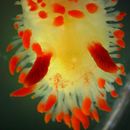Look Alikes
provided by Invertebrates of the Salish Sea
How to Distinguish from Similar Species: Triopha catalinae is also white and orange but it has fewer dorsal outgrowths and the orange spots can be found on the gills and on the dorsum. Okenia rosacea lives mainly farther south and has a rose-pink body.
- license
- cc-by-nc-sa
- copyright
- Rosario Beach Marine Laboratory
Habitat
provided by Invertebrates of the Salish Sea
On rocks, often near bryozoans
- license
- cc-by-nc-sa
- copyright
- Rosario Beach Marine Laboratory
Distribution
provided by Invertebrates of the Salish Sea
Geographical Range: Alaska to Bajia de los Angeles, Baja California, Mexico
- license
- cc-by-nc-sa
- copyright
- Rosario Beach Marine Laboratory
Habitat
provided by Invertebrates of the Salish Sea
Depth Range: Intertidal to 35 m. Mostly subtidal in southern parts of range.
- license
- cc-by-nc-sa
- copyright
- Rosario Beach Marine Laboratory
Comprehensive Description
provided by Invertebrates of the Salish Sea
This dorid nudibranch has a mid-dorsal anus toward the back of the dorsum, surrounded by the gills. The dorsum has many distinctive narrow, unbranched, club-shaped papillae. Those around the margins are longer while those nearer the center of the dorsum are shorter. The body is white or cream-colored and relatively flat, and the gills are short and white and sometimes difficult to see. A network of spicules can often be seen below the surface of the dorsum. Many of the papillae are tipped with bright orange, but the dorsum itself is not and the gills are often not either. The rhinophores are perfoliate and orange for most of their length. Length to 2.5 cm.
- license
- cc-by-nc-sa
- copyright
- Rosario Beach Marine Laboratory
Comprehensive Description
provided by Invertebrates of the Salish Sea
Biology/Natural History: In individuals near the southern end of the range there is a longitudinal row of orange-tipped tubercles or short papillae down the center of the dorsum. In more northern individuals such as this one these central tubercles tend to be white-tipped rather than orange-tipped and are more scattered than in a line, even though the more lateral tubercles and the rhinophores are orange-tipped. This species feeds on bryozoans such as Hinksina velata. Spawning is in spring in our area. Unlike most nudibranchs, the spiral ribbon of eggs that it lays is laid flat against the substrate rather than on edge.
- license
- cc-by-nc-sa
- copyright
- Rosario Beach Marine Laboratory
Limacia cockerelli
provided by wikipedia EN
Limacia cockerelli is a species of sea slug, a dorid nudibranch, a shell-less marine gastropod mollusc in the family Polyceridae.[2][3]
Distribution
This species is found from the West coast of North America, ranging from Vancouver Island, British Columbia, Canada to San Diego. It was also reported in the Gulf of California at Bahía de los Ángeles but those records are now known to be the similar species Limacia mcdonaldi.[4][5]
Description
This species reaches lengths of 26 mm (1.0 in). It has long dorsal papillae with orange-red tips and white branchial plumes with red tips.[6] There is a broad band of white tubercles down the middle of the dorsum which may sometimes have a small spot of orange at the apex. The second form, found in areas south of Point Conception has tubercles that are in a mid-dorsal line, slightly longer and tipped with orange.[7] Another form in California has large red blotches on the dorsum. The eggs of Limacia cockerelli are pink and develop after 17 days (at 10–13 °C [50–55 °F]) into hatching planktotrophic veligers. It was thought likely that the southern form represented a species complex.[8] This was confirmed in 2017 with the description of Limacia mcdonaldi.[5]
Diet
This animal preys exclusively on the orange-brown coloured bryozoan, Hincksina velata.[4]
Taxonomy
First described by Frank MacFarland in 1905 and originally named Laila cockerelli in honour of Theodore D. A. Cockerell.[1]
References
-
^ a b MacFarland, Frank Mace (1905) A preliminary account of the Dorididae of Monterey Bay, California. Proceedings of the Biological Society of Washington, 18: 35-54.
-
^ Bouchet, P. (2015). Limacia cockerelli (MacFarland, 1905). In: MolluscaBase (2015). Accessed through: World Register of Marine Species on 2015-12-22
-
^ Bouchet P. & Rocroi J.-P. (Ed.); Frýda J., Hausdorf B., Ponder W., Valdes A. & Warén A. (2005) Classification and nomenclator of gastropod families. Malacologia: International Journal of Malacology, 47(1-2). ConchBooks: Hackenheim, Germany. ISBN 3-925919-72-4. ISSN 0076-2997. 397 pp.
-
^ a b Goddard, J.H.R., 2000 (July 3) Limacia cockerelli (MacFarland, 1905). [In] Sea Slug Forum. Australian Museum, Sydney.
-
^ a b Uribe R.A., Sepúlveda F., Goddard J.H.R. & Valdés Á. (2017). Integrative systematics of the genus Limacia O. F. Müller, 1781 (Gastropoda, Heterobranchia, Nudibranchia, Polyceridae) in the Eastern Pacific. Marine Biodiversity. DOI 10.1007/s12526-017-0676-5
-
^ Behrens, D. (2006) Limacia cockerelli At Miller, M. (2015) The Slug Site.
-
^ McDonald, G., (2015) Limacia cockerelli Intertidal Invertebrates of the Monterey Bay Area, California
-
^ Caballer Gutiérrez, M., Almón Pazos, B., Pérez Dieste, J., (2015) The sea slug genus Limacia Müller, 1781 (Mollusca: Gastropoda: Heterobranchia) in Europe. Cahiers de Biologie Marine 57:35-42.
- license
- cc-by-sa-3.0
- copyright
- Wikipedia authors and editors
Limacia cockerelli: Brief Summary
provided by wikipedia EN
Limacia cockerelli is a species of sea slug, a dorid nudibranch, a shell-less marine gastropod mollusc in the family Polyceridae.
- license
- cc-by-sa-3.0
- copyright
- Wikipedia authors and editors

